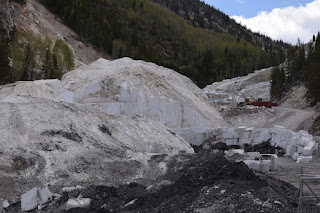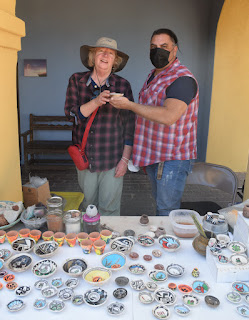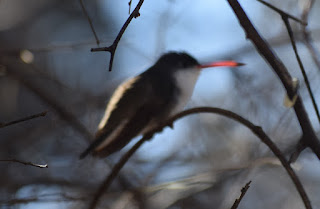On Wednesday we packed up the camper and headed east. We saw on and off rain, which became more intense as the day went on. We fueled in Fruita, and headed for downtown Grand Junction, and the Western History museum. It is a modest but professional museum focused on the history of the area. Sandi enjoyed the 1920's dresses. Richard was fascinated by the collection of guns carried by the Sheriffs over the years. The early sheriffs carried big six shooters; around 1910 they switched to semi-automatic pistols, then to police revolvers, smaller than the six shooters of the past, and finally to Glocks, which the police carry today. So they went from revolvers to semi-automatics to revolvers and then back to semi-automatics, which I might call a 720 degree turn. We were surprised to run into Ron and Judy in the museum; but we were all quite a ways from home. Sandi and I had lunch at the Trails Edge Brewery on Main St. Richard was interested in the public art, found on every corner. We headed east towards Grand Mesa. We did not get very far on highway 65 until we ran into a state police roadblock due to a major accident. We headed back towards Grand Junction, and turned off to Clifton and Delta, in order to get to the Grand Mesa from the other side. The rain kept falling, intensely at times. Richard was tired by the time we arrived, around 6 PM. Perhaps we should have stopped earlier. We found a campsite in Little Bear campground, and camped in the rain. The forecast is for more rain......
On Thursday morning,, we woke up in the clouds. We had rain on and off thoughout the day, but we did see some sun. Richard did some fishing in the morning, and Sandi took a walk. The campground host saw Richard, and we paid $20 for two nights, thanks to the senior pass. We walked around the area, and found the Island Lake campground, and the boat ramp. Sandi liked the water gushing down the rocks below the dam. We headed over to the nice visitor center, where Rocky Mountain Conservancy assists the forest service with staffing. We were also able to check email using their WIFI. We took a drive to Mesa Lakes, looking for moose, but they did not show.
We drove out along the edge of the mesa to Land's End, which had a spectacular view, including Grand Junction and the Manti-La Sal mountains. We saw a Steller's Jay and some Clark Nutcrackers. We saw a lot of cows, and stopped at an old cowboy camp. We came back, and Richard did some fishing while Sandi fixed a good dinner. Richard fished after dinner as well, but no luck. Richard did some research, and concluded that we could fuel and dump in Delta. Our plan is to drive to the campground at Black Canyon of the Gunnison NP, and then drive to Montrose to see the Ute museum.
 |
| 1800 feet down |
On Friday, we headed down from the mesa to Delta, where we bought fuel and dumped. Sandi suggested that we go directly to the Black Canyon of the Gunnison NP, to arrive early to get a campsite. Most of the sites are reservable, but one loop is first come first serve. We picked a campsite that looked good, but the person who was there the night before showed up with a new stub for today, so we kept looking. We ended up in a site that was tight, but workable; it took a while to get the rig in. We learned that there was a Hispanic event at the Ute Museum on Saturday, so we decided not to go on Friday, and headed for the park Visitor Center. We caught a talk on earth-like planets in other solar systems. We drove the rim road, stopped at overlooks, and chatted with other visitors. We returned about 5 PM, and Sandi cooked dinner on the grille. We walked over to the ampitheatre, and set up our chairs in the back. The place filled up gradually. The speaker was talking about dark skies and lighting, urging us to minimize outside lighting, and suggesting the blue light was not good for our sleep. They had telescopes set up after the talk, but the lines were long, so we returned to our own picnic table to admire the milky way. The Sky Guide app on Richard's phone let us identify stars and planets.
On Saturday, the skies were blue, and we headed to Montrose for the Culture Fest at the Ute museum. We enjoyed the event very much, and chatted at length with the local community radio station manager, the Spanish teacher who was raising money to send students to Peru, and folks from the local Art Council. We ate ethnic food, including pupusas. The museum was also interesting; we learned about the three Ute Indian tribes, and visited Chipeta's grave. Chipeta was the wife of the great Ute chief Ouray. We attended another sky talk at the ampitheatre that night, showing us constellations. We left in the middle of the second program of “live” photos of stars.
On Sunday we headed east, stopped in Gunnison for fuel and coffee, and drove over over Monarch Pass. We were headed for the mining museum in Leadville. The museum was more extensive than we had expected, including dioramas, a simulated mine, information about mining, and a gift shop. We spent the most time watching the video tour of the Marble quarry in Marble Colorado, especially since we had recently been to Marble. We stayed until the museum closed, and did not see everything. We then headed for Turquoise Lake, and went to the Matchless campground, which looked like a large parking lot near the lake. We drove through the Silver Dollar campground, but saw nothing that looked good, so we headed back to the parking lot. Our site including a fire pit, a picnic table, and a view of the lake, so not really a bad site. Sandi cooked a good dinner on the fire.
On Monday we had a routine drive home.














































